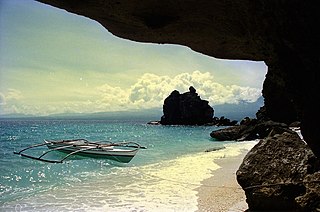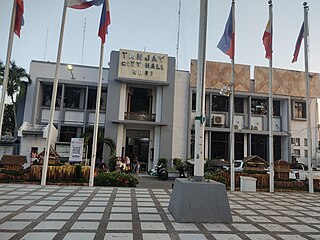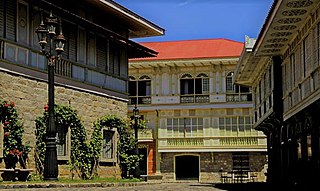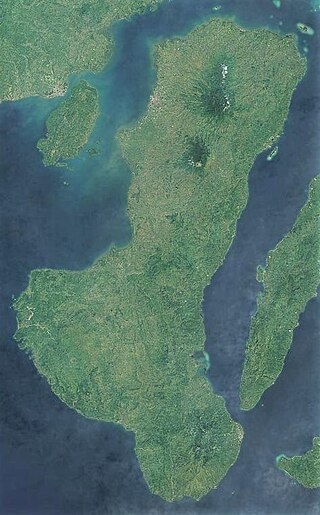
Negros Oriental, officially the Province of Negros Oriental, is a province in the Philippines located in the Negros Island Region. Its capital is the city of Dumaguete, one of the two regional centers of Negros Island Region. It occupies the southeastern half of the large island of Negros, and borders Negros Occidental, which comprises the northwestern half. It also includes Apo Island, a popular dive site for both local and foreign tourists.

Negros Occidental, officially the Province of Negros Occidental, is a province in the Philippines located in the Negros Island Region. Its capital is the city of Bacolod, of which it is geographically situated and grouped under by the Philippine Statistics Authority, but remains politically independent from the provincial government and also one of the two regional centers in Negros Island Region. It occupies the northwestern half of the large island of Negros, and borders Negros Oriental, which comprises the southeastern half. Known as the "Sugarbowl of the Philippines", Negros Occidental produces more than half the nation's sugar output.

Bacolod, officially the City of Bacolod, is a 1st class highly urbanized city in the Negros Island Region in the Philippines. With a total of 600,783 inhabitants as of the 2020 census, it is the most populous city in the Negros Island Region and the second most populous city in the entire Visayas after Cebu City.

Tanjay, officially the City of Tanjay, is a 4th class component city in the province of Negros Oriental, Philippines. According to the 2020 census, it has a population of 82,642 people.

Bago, officially the City of Bago, is a 2nd class component city in the province of Negros Occidental, Philippines. According to the 2020 census, it has a population of 191,210 people.

Kabankalan, officially the City of Kabankalan, is a 1st class component city in the province of Negros Occidental, Philippines. According to the 2020 census, it has a population of 200,198 people making it the second most populous city in Negros Occidental next to Bacolod. The city is applying for a Highly Urbanized City (HUC).

Silay, officially the City of Silay, is a 3rd class component city in the province of Negros Occidental, Philippines. According to the 2020 census, it has a population of 130,478 people.

Juan Anacleto Araneta y Torres was a Filipino sugar farmer and revolutionary leader during the Negros Revolution.

The architecture of the Philippines reflects the historical and cultural traditions in the country. Most prominent historic structures in the archipelago are influenced by Austronesian and American architectures.

The Mariano Ramos Ancestral House is the home of the late Mariano Ramos, one of the first appointed Presidente Municipals of Bacolod, Philippines. The house was built in the 1930s with its architecture being a combination of Castilian and Tuscan styles. It comprises three storeys including the tower room, known as the torre or mirador.

Ancestral houses of the Philippines or Heritage Houses are homes owned and preserved by the same family for several generations as part of the Filipino family culture. It corresponds to long tradition by Filipino people of giving reverence for ancestors and elders. Houses could be a simple house to a mansion. The most common ones are the "Bahay na Bato". Some houses of prominent families had become points of interest or museums in their community because of its cultural, architectural or historical significance. These houses that are deemed of significant importance to the Filipino culture are declared Heritage House by the National Historical Commission of the Philippines (NHCP), previously known as the National Historical Institute (NHI) of the Philippines. Preservation is of utmost importance as some ancestral houses have come into danger due to business people who buy old houses in the provinces, dismantle them then sell the parts as ancestral building materials for homeowners wishing to have the ancestral ambiance on their houses. These ancestral houses provide the current generation a look back of the country's colonial past through these old houses.

Bacolod–Silay International Airport, is an airport serving the general area of Metro Bacolod, located in the Negros Island Region of the Philippines.

Negros is the fourth largest and third most populous island in the Philippines, with a total land area of 13,309 km2 (5,139 sq mi). The coastal zone of the southern part of Negros is identified as a site of highest marine biodiversity importance in the Coral Triangle.

On May 14, 2008, the two-storey Gala–Rodriguez house was declared by the National Historical Institute of the Philippines as one of the three heritage houses in Sariaya, due to its notable historical and cultural significance. Designed by Dr. Juan Nakpil in the early 1930s, it was owned by one of the most distinguished couples in Quezon, Dr. Isidro Rodriguez and Doña Gregoria Gala. The house is located in Rizal Street along with other opulent houses owned by the illustrados of old Sariaya. It is listed as one of the Ancestral Houses in the Philippines, under Region IV-A.

The Hofileña Ancestral House is the residence of Manuel Severino Hofileña and his family located in Cinco de Noviembre Street, Silay, in the province of Negros Occidental, Philippines. The home was built by Hofileña for his wife Gilda Ledesma Hojilla, a former Miss Silay, and their nine children.

The Bernardino Jalandoni Museum, also known as the Bernardino Jalandoni House, located along Rizal Street, Silay City, in the province of Negros Occidental, Philippines, is the original residence of the late Don Bernardino and Doña Ysabel Jalandoni. The museum is also known as the "Pink House" because of its conspicuous pink paint that easily grabs attention.

Granada is a former town and constituent barangay of Bacolod. Located on the easternmost portion of the city, it borders Northern Negros Natural Park.

The Mercado Mansion is a heritage house located in Carcar, Cebu, Philippines. It is a two-storey bahay-na-bato painted Mediterranean blue owned by the Mercado clan along Cebu South Road. It was declared a Heritage House by the National Historical Commission of the Philippines in 2009.

Hacienda Rosalia, also known as Hacienda Santa Rosalia, is a compound where the ancestral home mansion of Gaston family and the Church of Cartwheels are located. It is situated in Manapla, Negros Occidental, Philippines. The mansion was built in 1930s.
The Dizon-Ramos Museum is situated in Bacolod, Negros Occidental, Philippines beside the Mariano Ramos Ancestral House.






























